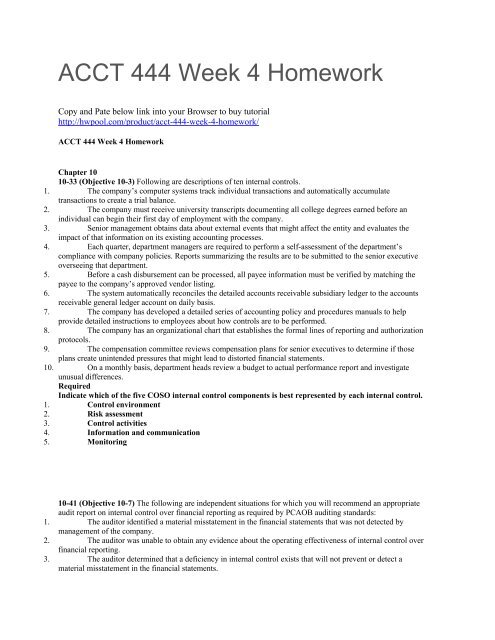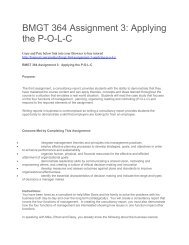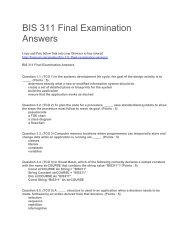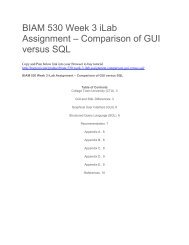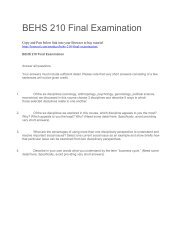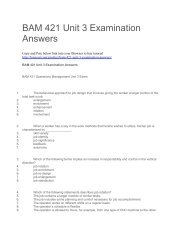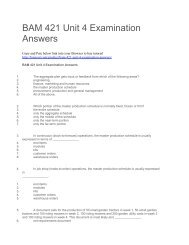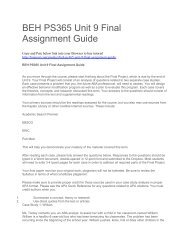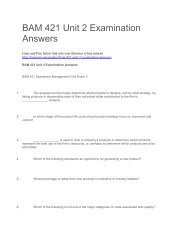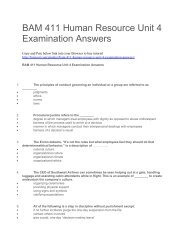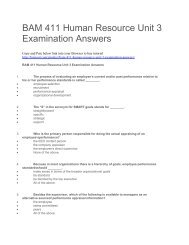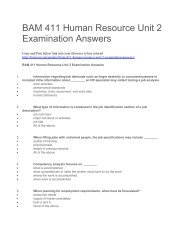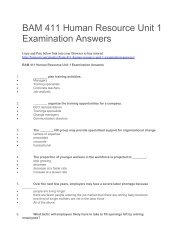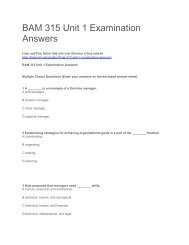ACCT 444 Week 4 Homework
You also want an ePaper? Increase the reach of your titles
YUMPU automatically turns print PDFs into web optimized ePapers that Google loves.
<strong>ACCT</strong> <strong>444</strong> <strong>Week</strong> 4 <strong>Homework</strong><br />
Copy and Pate below link into your Browser to buy tutorial<br />
http://hwpool.com/product/acct-<strong>444</strong>-week-4-homework/<br />
<strong>ACCT</strong> <strong>444</strong> <strong>Week</strong> 4 <strong>Homework</strong><br />
Chapter 10<br />
10-33 (Objective 10-3) Following are descriptions of ten internal controls.<br />
1. The company’s computer systems track individual transactions and automatically accumulate<br />
transactions to create a trial balance.<br />
2. The company must receive university transcripts documenting all college degrees earned before an<br />
individual can begin their first day of employment with the company.<br />
3. Senior management obtains data about external events that might affect the entity and evaluates the<br />
impact of that information on its existing accounting processes.<br />
4. Each quarter, department managers are required to perform a self-assessment of the department’s<br />
compliance with company policies. Reports summarizing the results are to be submitted to the senior executive<br />
overseeing that department.<br />
5. Before a cash disbursement can be processed, all payee information must be verified by matching the<br />
payee to the company’s approved vendor listing.<br />
6. The system automatically reconciles the detailed accounts receivable subsidiary ledger to the accounts<br />
receivable general ledger account on daily basis.<br />
7. The company has developed a detailed series of accounting policy and procedures manuals to help<br />
provide detailed instructions to employees about how controls are to be performed.<br />
8. The company has an organizational chart that establishes the formal lines of reporting and authorization<br />
protocols.<br />
9. The compensation committee reviews compensation plans for senior executives to determine if those<br />
plans create unintended pressures that might lead to distorted financial statements.<br />
10. On a monthly basis, department heads review a budget to actual performance report and investigate<br />
unusual differences.<br />
Required<br />
Indicate which of the five COSO internal control components is best represented by each internal control.<br />
1. Control environment<br />
2. Risk assessment<br />
3. Control activities<br />
4. Information and communication<br />
5. Monitoring<br />
10-41 (Objective 10-7) The following are independent situations for which you will recommend an appropriate<br />
audit report on internal control over financial reporting as required by PCAOB auditing standards:<br />
1. The auditor identified a material misstatement in the financial statements that was not detected by<br />
management of the company.<br />
2. The auditor was unable to obtain any evidence about the operating effectiveness of internal control over<br />
financial reporting.<br />
3. The auditor determined that a deficiency in internal control exists that will not prevent or detect a<br />
material misstatement in the financial statements.
4. During interim testing, the auditor identified and communicated to management a significant control<br />
deficiency. Management immediately corrected the deficiency and the auditor was able to sufficiently test the<br />
newly-instituted internal control before the end of the fiscal period.<br />
5. As a result of performing tests of controls, the auditor identified a significant deficiency in internal<br />
control over financial reporting; however, the auditor does not believe that it represents a material weakness in<br />
internal control.<br />
Required<br />
For each situation, state the appropriate audit report from the following alternatives:<br />
Unqualified opinion on internal control over financial reporting<br />
Qualified or disclaimer of opinion on internal control over financial reporting<br />
Adverse opinion on internal control over financial reporting<br />
Chapter 12<br />
12-19 (Objectives 12-2, 12-3) The following are misstatements that can occur in the sales and collection cycle:<br />
1. A customer number on a sales invoice was transposed and, as a result, charged to the wrong customer.<br />
By the time the error was found, the original customer was no longer in business.<br />
2. A former computer operator, who is now a programmer, entered information for a fictitious sales return<br />
and ran it through the computer system at night. When the money came in, he took it and deposited it in his own<br />
account.<br />
3. A nonexistent part number was included in the description of goods on a shipping document. Therefore,<br />
no charge was made for those goods.<br />
4. A customer order was filled and shipped to a former customer that had already filed for bankruptcy.<br />
5. The sales manager approved the price of goods ordered by a customer, but he wrote down the wrong<br />
price.<br />
6. A computer operator picked up a computer-based data file for sales of the wrong week and processed<br />
them through the system a second time.<br />
7. For a sale, a data entry operator erroneously failed to enter the information for the salesman’s<br />
department. As a result, the salesman received no commission for that sale.<br />
8. Several remittance advices were batched together for inputting. The cash receipts clerk stopped for<br />
coffee, set them on a box, and failed to deliver them to the data input personnel.<br />
Required<br />
1. Identify the transaction-related audit objective(s) to which the misstatement pertains.<br />
2. Identify one automated control that would have likely prevented each misstatement.
12-26 (Objective 12-4) Following are 10 key internal controls in the payroll cycle for Gilman Stores, Inc.<br />
Key Controls<br />
1. To input hours worked, payroll accounting personnel input the employee’s Social Security number. The<br />
system does not allow input of hours worked for invalid employee numbers.<br />
2. The payroll application is programmed so that only human resource personnel are able to add employee<br />
names to the employee master files.<br />
3. Input menus distinguish executive payroll, administrative payroll, and factory payroll.<br />
4. The system automatically computes pay at time and a half once hours worked exceed 80 in a 2-week<br />
pay period.<br />
5. The system accumulates totals each pay period of employee checks processed and debits the payroll<br />
expense general ledger account for the total amount.<br />
6. Each pay period, payroll accounting clerks count the number of time cards submitted by department<br />
heads for processing and compare that total with the number of checks printed by the system to ensure that each<br />
time card has a check.<br />
7. For factory personnel, the payroll system matches employee ID numbers with ID numbers listed on job<br />
costing tickets as direct labor per the cost accounting system. The purpose of the reconciliation is to verify that<br />
the amount paid to each employee matches the amount charged to production during the time period.<br />
8. The system generates a listing by employee name of checks processed. Department heads review these<br />
listings to ensure that each employee actually worked during the pay period.<br />
9. On a test basis, payroll accounting personnel obtain a listing of pay rates and withholding information<br />
for a sample of employees from human resources to recalculate gross and net pay.<br />
10. The system automatically rejects processing an employee’s pay if inputted hours exceed 160 hours for a<br />
2-week pay period.<br />
Required<br />
For each control:<br />
1. Identify whether the control is an automated application control (AC) or a manual control done<br />
by Gilman employees (MC).<br />
2. Identify the transaction-related audit objective that is affected by the control.<br />
3. Identify which controls, if tested within the last two prior year audits, would not have to be<br />
retested in the current year, assuming there are effective IT general controls and no changes to the noted<br />
control have been made since auditor testing was completed.


